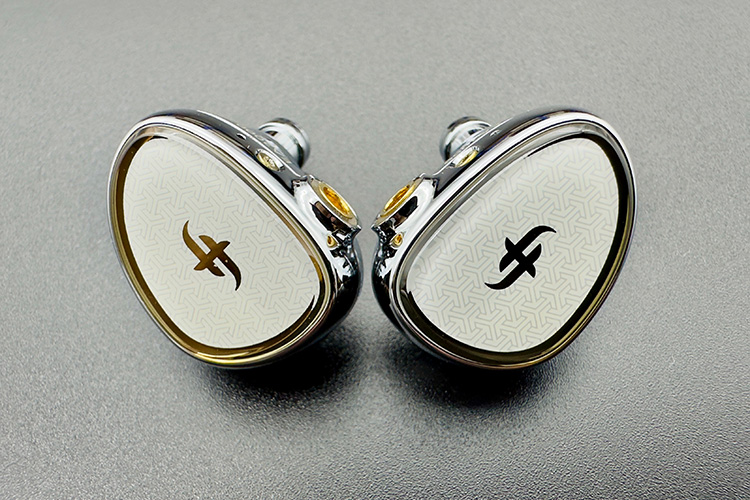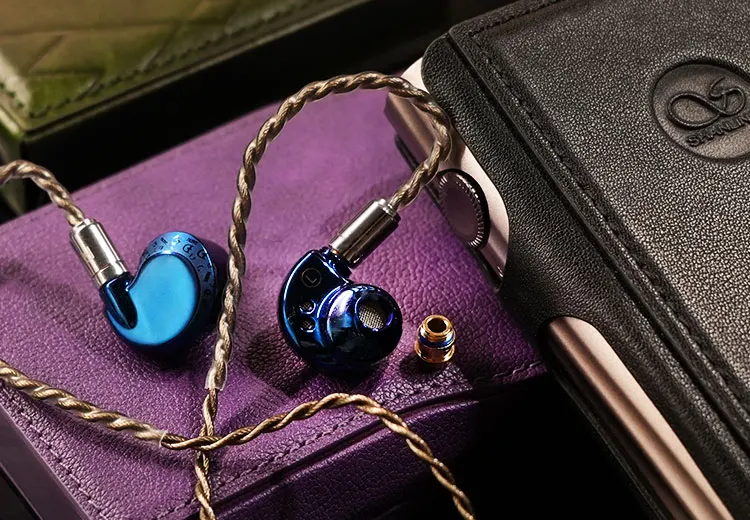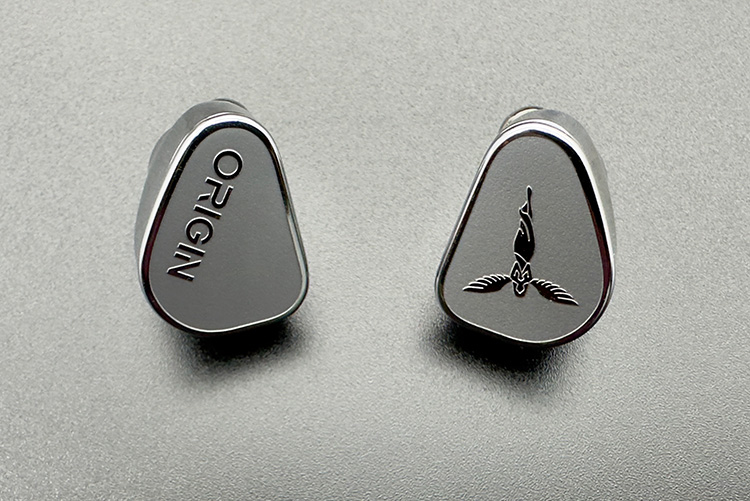Synergy
The EA2000 has an impedance of 23Ω @1kHz and a sensitivity rating of 114 dB/Vrms. These IEMs are quite easy to drive and pair easily with almost all sources.
With powerful sources such as Earmen Angel, the EA2000 can pick up background static hisses while being quieter with DAPs and dongles with a completely noise-free background. The EA2000 can be driven easily with low power sources, as can mobile phones too.
Considering their bright profile, these IEMs can be best paired with a warm source. It helps in adding richness and smoothness to the rather thin upper mids providing a more pleasant tonal balance.
Select Comparisons
Simgot EA1000
Technical
The Simgot EA1000 “Fermat” is a single 10mm dynamic driver IEM with a 6mm passive radiator. These IEMs were released after the EA2000, and sound wise they can be considered an upgrade to the EA2000. However, the EA1000 sells cheaper than the EA2000.
It has an impedance of 16Ω and a sensitivity of 127 dB @1kHz/Vrms which makes it efficient even with low power input. Both of these IEMs are quite easy to drive.
The EA1000 comes in three different tuning nozzles, which mostly alter the signature in the upper frequencies. The difference in sound signature is mostly noticeable in how bright they sound.
Design
The design of both of these IEMs is nearly identical, right down to the faceplate, making it challenging to tell them apart from afar. The unboxing experience with EA2000 is a lot better. Both packages have the same case and a similar set of ear tips.
The shells of EA1000 are smaller in size, and the weight is almost similar on both IEMs. The nozzle is short and wide compared to the EA2000. I find the fit on both of these IEMs similar; the EA2000 may have an edge because of its longer nozzle.
The included cable with the EA1000 is of decent quality and comes only with a single-ended 3.5mm plug. The stock cable is better on the EA2000, and the tuning plugs add versatility too.
Performance
Bass on the EA1000 has a better response. The quantity and quality of bass are higher on the EA1000. The reverberating nature of the bass on the EA1000 lends it a more natural feel.
Despite both IEMs featuring additional passive radiators, the additional driver in the EA2000 doesn’t notably enhance its bass performance, which tends to be leaner compared to the EA1000.
In the mids department, the EA1000 has an edge over the EA2000. EA1000 has more forward mids. The bass quantity adds to thickness in the mids region, and thus there is more tonal weight on the EA1000. EA2000 has a thinner midrange.
In the treble region, both of these pairs have a good amount of energy. The EA1000 is noticeably brighter and has more energy up top. The upper frequencies are more extended on the EA2000. The sense of airiness is more on the EA2000.
In terms of soundstage, the EA2000 has an edge due to its spacious and airy sound. The EA1000 has more of an intimate soundstage. Both pairs have similar imaging quality. I rank the EA2000 as more technically capable.
Overall, the sound on the EA1000 seems to be an upgrade over the EA2000, which limits the use case for the latter. Probably, Simgot knew what was missing in the EA2000 and improved with the EA1000.
DUNU Falcon Ultra
Technical
The DUNU Falcon Ultra is a single dynamic driver iem with a Lithium-Magnesium alloy diaphragm and an upgraded architecture over the previous generation.
It has an impedance of 16Ω and a sensitivity of 108 dB @ 1kHz/Vrms. The Falcon Ultra is easy to drive and does not ask for plenty of power.
These IEMs are equipped with two interchangeable nozzles: one made of stainless steel and the other crafted from gold-plated brass.
The stainless steel nozzle offers a brighter sound profile, with added energy in the upper mids and treble regions.
Conversely, the gold nozzle provides balanced tuning with a hint of warmth, with less emphasis on the upper frequencies compared to the other nozzle. Personally, I lean towards using the gold nozzle on these IEMs.
Design
The Falcon Ultra shells have an all-metal body and come in an attractive deep blue color. The shells are similarly sized and have an equally good fit as the EA2000. They weigh nearly the same, too.
The Falcon Ultra stock cable is a 4-core Silver-Plated copper Litz cable. The cable connection on the Falcon Ultra is MMCX, and the cable is modular.
It comes in three different adapters – 3.5mm, 4.4mm, and 6.5mm. In terms of quality, I find this cable comparable to the one on the EA2000, though they are built differently.
Performance
In terms of bass, Falcon leads in quantity, while the quality is comparable. The sub-bass presence on the Falcon Ultra (on both the nozzles) is more pronounced than on the EA2000. The bass is more enjoyable on Falcon Ultra as it goes deeper and has more punch and impact.
The midrange again performs similarly throughout the frequency range on both, with an extra tonal weight in the mids on the Falcon Ultra. The upper mids on Falcon Ultra (the gold nozzle) have less energy. Overall, the mids on the EA2000 are thinner.
In the lower treble region, EA2000 has more energy and can sometimes seem harsh, a similar character that the Falcon Ultra (on the blue nozzle) occasionally exhibits. The thinness in the treble range makes it less enjoyable on the EA2000 than the Falcon Ultra.
The Falcon Ultra exhibits a balanced, richer, and smoother sound with the brass filter, particularly enhancing its bass response, unlike the EA2000, which appears leaner and lacks the same level of punchiness.
On the technical front, the EA2000 has a wider soundstage and more open sound. The soundstage on the Falcon Ultra is narrow, and the imaging is as good as the EA2000.
Tanchjim Origin
Technical
The Tanchjim Origin features an in-house developed 5th Generation DMT 10mm dynamic driver. The Origin has an impedance of 16Ω @1kHz and a sensitivity rating of 126db/Vrms making it easy to drive.
Even so, it may take a few extra clicks of the volume button. Noticeably, with a higher sound, the Origin does not get extra loud.
The Origin offers three distinct types of nozzles to add versatility to the sound experience, yet the variation in sound among these nozzles is minimal, making the differences hardly noticeable.
Design
The shells of the Origin are made of stainless steel, have a mirror-like finish, and feel highly durable. Shells are on the smaller side and weigh nearly the same as the EA2000.
The cable on the EA2000 is noticeably better than that on the Origin. The Origin’s cable only comes with a 3.5mm adapter and is very thin and delicately built.
The nozzles on the Origin are of normal length, which is not very long or short either. They have a wide bore, and fit-wise they are as comfortable as the EA2000, with an edge to the Origin because of its smaller size.
Performance
The bass on the Origin has noticeably better quantity yet maintains a similar level of quality. The midbass is more pronounced on the Origin, but it doesn’t encroach upon the midrange. Conversely, the bass of the EA2000 exhibits a lean profile and lacks body in the midbass region.
When comparing midranges, the Origin pushes ahead of the EA2000 with its extra weight in notes and a richer, more melodious sound.
The Origin maintains a similar level of clarity and resolution in the midrange. The EA2000 exhibits noticeable thinness and extra energy in the upper midrange, making it less enjoyable compared to the Origin.
In terms of technical capabilities, I find these IEMs nearly on the same level. The soundstage has decent height and width on both of these IEMs. The Origin has more open sound and reaches far and wide than the EA2000.
All this said, I prefer the Origin’s sound signature as it is balanced with a slight bass boost, and the fuller midrange adds an extra touch of sweetness.
Our Verdict
Undoubtedly, The SIMGOT EA2000 stands out as an impressive release by Simgot. Its technical prowess is evident, and the user experience it offers is commendable. It gets a recommendation from me based on multiple parameters.
However, the introduction of the EA1000, evidently superior in sound quality and priced lower than the EA2000, raises questions about the latter’s future. Will Simgot phase out the EA2000 in light of this? That’s something we will have to wait for and watch.
Simgot EA2000 Boson Specifications
- Driver: 12mm double magnetic circuit double tone dynamic driver + 6mm passive radiator
- Response frequency: 10Hz-50kHz
- Sensitivity: 114dB(@ 1000Hz)
- Impedance: 23Ω±15%(@1000Hz)
- Distortion degree: <1%
- Vocal tract difference: <1.0dB(@ 1000Hz)
- Cable: 8-strand high purity oxygen free copper silver plated wire
- IEM body material: Aluminum alloy five-axis CNC carved with high transparency crystal glass panel









